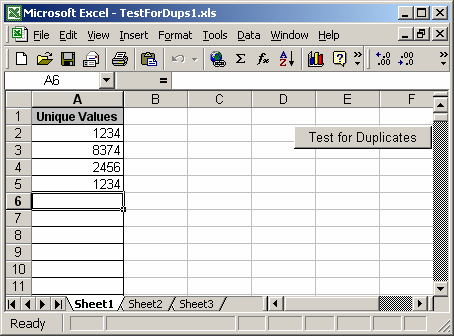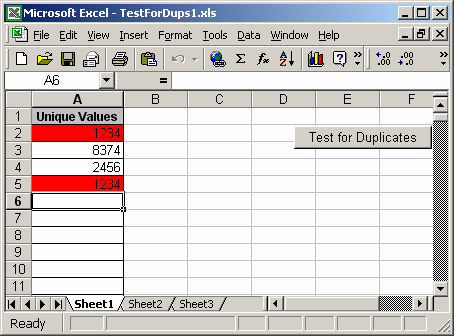
MS Excel 2003: Test for duplicates in a column
This Excel tutorial explains how to write a macro to test for duplicates in a column in Excel 2003 and older versions (with screenshots and step-by-step instructions).
Question: In Microsoft Excel 2003/XP/2000/97, is it possible to write a macro which would highlight any duplicate values in column A?
Answer: Let's look at an example.
Download Excel spreadsheet (as demonstrated below)

In our spreadsheet, we've set up column A to contain unique values. On this sheet, we've created a button that when clicked will launch a macro. This macro will highlight any duplicate values in column A.
In our example, we've clicked on the button. Now the background color of the duplicates will turn red as follows:

In this example, the same value has been entered in both cells A2 and A5.
You can press Alt+F11 to view the VBA code.
Please note that the LRows variable in this macro is set to 200 indicating that the macro will test the first 200 rows in column A for duplicates. You may need to change this value to accommodate your volume of data.
Macro Code
The macro code looks like this:
Sub TestForDups()
Dim LLoop As Integer
Dim LTestLoop As Integer
Dim LClearRange As String
Dim Lrows As Integer
Dim LRange As String
Dim LChangedValue As String
Dim LTestValue As String
'Test first 200 rows in spreadsheet for uniqueness
Lrows = 200
LLoop = 2
'Clear all flags
LClearRange = "A2:A" & Lrows
Range(LClearRange).Interior.ColorIndex = xlNone
'Check first 200 rows in spreadsheet
While LLoop <= Lrows
LChangedValue = "A" & CStr(LLoop)
If Len(Range(LChangedValue).Value) > 0 Then
'Test each value for uniqueness
LTestLoop = 2
While LTestLoop <= Lrows
If LLoop <> LTestLoop Then
LTestValue = "A" & CStr(LTestLoop)
'Value has been duplicated in another cell
If Range(LChangedValue).Value = Range(LTestValue).Value Then
'Set the background color to red
Range(LChangedValue).Interior.ColorIndex = 3
Range(LTestValue).Interior.ColorIndex = 3
End If
End If
LTestLoop = LTestLoop + 1
Wend
End If
LLoop = LLoop + 1
Wend
End Sub
Advertisements


